Ticino Canton
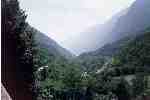 After crossing the St. Gotthard Pass the route descends dramatically into the lush Leventina Valley and follows the Ticino River. This is another Switzerland. The Swiss took the canton of Ticino from Italy in 1512 and never gave it back. The ambiance is steeped in Mediterranean culture. The language is Italian, and the architecture, food, and climate is decidedly southern. It's a unique mix of Swiss efficiency and Italian dolce vita. It's also a great ride down the valley. Twenty miles of downhill, dropping 2500 ft. in elevation. There was a 4 mile stretch where it seemed pedaling was absolutely unnecessary.
After crossing the St. Gotthard Pass the route descends dramatically into the lush Leventina Valley and follows the Ticino River. This is another Switzerland. The Swiss took the canton of Ticino from Italy in 1512 and never gave it back. The ambiance is steeped in Mediterranean culture. The language is Italian, and the architecture, food, and climate is decidedly southern. It's a unique mix of Swiss efficiency and Italian dolce vita. It's also a great ride down the valley. Twenty miles of downhill, dropping 2500 ft. in elevation. There was a 4 mile stretch where it seemed pedaling was absolutely unnecessary.
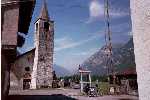 The valley is dotted with picturesque, medieval villages built of granite quarried from the mountainsides. Even in these idyllic surroundings one is never too far from the ubiquitous SwissCom phone booth. The vegetation changes to vineyards, chestnut groves, and subtropical flowers.
The valley is dotted with picturesque, medieval villages built of granite quarried from the mountainsides. Even in these idyllic surroundings one is never too far from the ubiquitous SwissCom phone booth. The vegetation changes to vineyards, chestnut groves, and subtropical flowers.
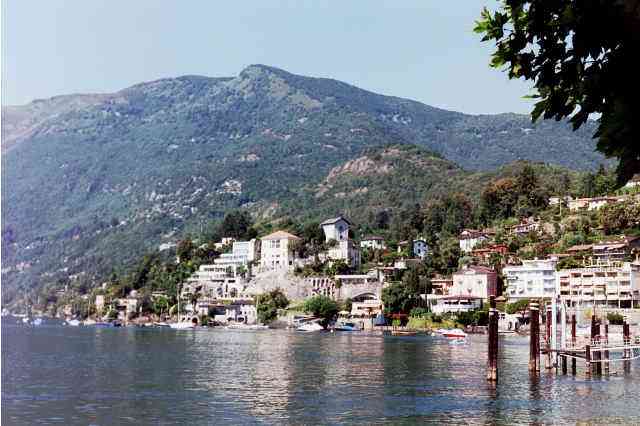
We really sensed the Italian influence on the culture and architecture after arriving in Locarno. We stayed overnight in a comfortable youth hostel. The next morning we biked along the palm treed shoreline of Lago di Maggiore, basking in the warm Mediterranean sun on our way to the nearby resort town of Ascona. The pastel colored buildings stair-stepped down from the Monte Veritŕ to the crystal clear waters of the lake - La Dolce Vita!
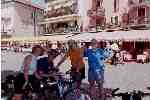 The broad cobblestone promenade of Piazza Giuseppe Motta was lined with colorful awning-covered outdoor cafes. Here we had a wonderful lunch under the yellow umbrellas of Al Pontile Ristorante while watching the tourists and locals strolling the tree-lined lakeshore promenade. We picked up some straw souvenir hats that came in handy in the relentless sun. More stylish than bike helmets, we think they added a sophisticated look to the new "locals".
The broad cobblestone promenade of Piazza Giuseppe Motta was lined with colorful awning-covered outdoor cafes. Here we had a wonderful lunch under the yellow umbrellas of Al Pontile Ristorante while watching the tourists and locals strolling the tree-lined lakeshore promenade. We picked up some straw souvenir hats that came in handy in the relentless sun. More stylish than bike helmets, we think they added a sophisticated look to the new "locals".
Leaving the productive farming delta of the Ticino River, we took a short train ride to the top of Monte Ceneri and then biked along the narrow edge of Lago di Lugano to the small fishing village of Figino. The youth hostel is a large, four story, former patrician's house with 27 bedrooms totaling 160 beds. Before we sat down to the family style spaghetti dinner in the hostel's outdoor courtyard, we took a swim at the town beach and shared a bottle of local Merlot.
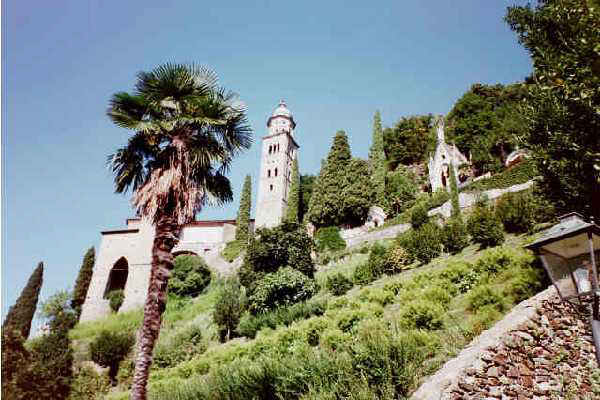 On our way from Figino to the Italian border we passed through the lovely village of Morcote. Nestled along the shore of Lago di Lugano, a terraced hillside rises behind the town and leads up to Chiesa St. Maria del Sasso (Church of St Maria of the Rock). The winding road following the shoreline provides superlative cycling. We're getting used to seeing palm trees in Switzerland.
On our way from Figino to the Italian border we passed through the lovely village of Morcote. Nestled along the shore of Lago di Lugano, a terraced hillside rises behind the town and leads up to Chiesa St. Maria del Sasso (Church of St Maria of the Rock). The winding road following the shoreline provides superlative cycling. We're getting used to seeing palm trees in Switzerland.
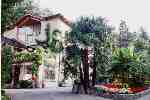 This youth hostel in Lugano may be one of the best among Hostelling International's affiliates in Europe. The lady who runs the hostel told us her parents operated the facility before her. With the beautiful grounds, splashing fountains and outdoor pool surrounded by trees and garden, it almost feels like you're staying with rich relatives in Ticino. Although it's located in Savosa, a suburb a bit removed from the city center, it's worth the extra couple miles.
This youth hostel in Lugano may be one of the best among Hostelling International's affiliates in Europe. The lady who runs the hostel told us her parents operated the facility before her. With the beautiful grounds, splashing fountains and outdoor pool surrounded by trees and garden, it almost feels like you're staying with rich relatives in Ticino. Although it's located in Savosa, a suburb a bit removed from the city center, it's worth the extra couple miles.
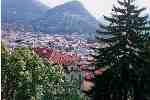 Here's a view of Lugano from our room in another wonderful hostel, the Backpacker's Montarina. This independent hostel is a former villa set in a forest of palm trees on a hill behind the train station. It's an oasis of green fronds with an Olympic size swimming pool. We stayed in a separate building with hotel-like rooms and our own baths. It was more expensive than the Savosa hostel, but the place was spotless, the staff was very friendly, breakfast was in the hotel next door, and they sold beer at the pool! Need we say more?
Here's a view of Lugano from our room in another wonderful hostel, the Backpacker's Montarina. This independent hostel is a former villa set in a forest of palm trees on a hill behind the train station. It's an oasis of green fronds with an Olympic size swimming pool. We stayed in a separate building with hotel-like rooms and our own baths. It was more expensive than the Savosa hostel, but the place was spotless, the staff was very friendly, breakfast was in the hotel next door, and they sold beer at the pool! Need we say more?
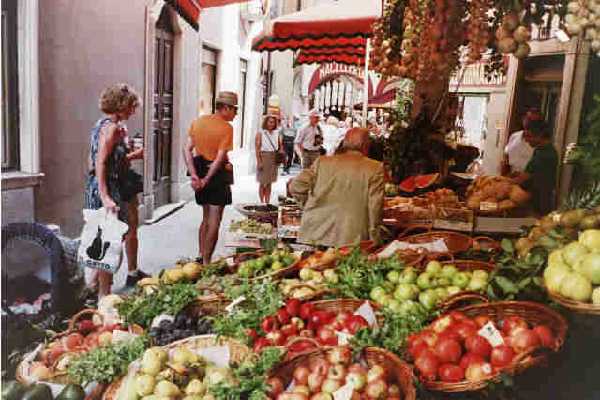 Lugano is the largest and liveliest city in the canton of Ticino. The arcades of the piazze offer lots of enticing outdoor cafes and markets. In the evening, a convenient cable car whisked us from the Montarina hostel down to the waterfront where an enterprising maitre d' hotel spotted five hungry looking cyclists walking near his outdoor café. With a few words of Italian and a wave of his hands he guided us to an available table. We obediently followed and listened to our server's advice in ordering the day's special, a Mediterranean seafood paella over rice. Being more than ready for dinner we were easy marks, especially with the language barrier. As it turned out, we enjoyed the largest variety of sea creatures than ever before at one sitting. We may not have been able to identify all the species presented on the table but it was one of the best meals on the trip.
Lugano is the largest and liveliest city in the canton of Ticino. The arcades of the piazze offer lots of enticing outdoor cafes and markets. In the evening, a convenient cable car whisked us from the Montarina hostel down to the waterfront where an enterprising maitre d' hotel spotted five hungry looking cyclists walking near his outdoor café. With a few words of Italian and a wave of his hands he guided us to an available table. We obediently followed and listened to our server's advice in ordering the day's special, a Mediterranean seafood paella over rice. Being more than ready for dinner we were easy marks, especially with the language barrier. As it turned out, we enjoyed the largest variety of sea creatures than ever before at one sitting. We may not have been able to identify all the species presented on the table but it was one of the best meals on the trip.
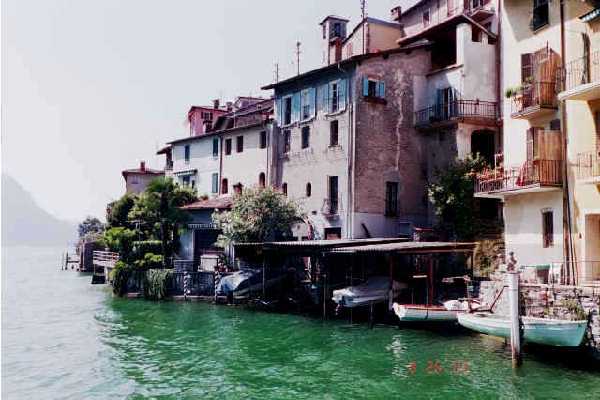 The extra day in Lugano allowed us to explore a bit beyond the city's boundaries. We traveled by ferry a short distance up the lake to Gandria. The buildings along the shore cling to the hillside in this enchanting former fishing village. Once off the ferry, passengers climb stairs up to a warren of narrow alleys and walkways leading to shops and private residences. We stopped for a drink at a restaurant overlooking the lake and the Italian shore a half mile away. Cars are prohibited and the town enforces strict construction ordinances which have preserved the old world atmosphere. While hiking back to Lugano we stopped at a local artist's gallery and struck up a conversation with a young woman who spoke perfect English. Her father was the artist and she learned English while spending a year as an exchange student in Ohio, very close to where we live in Cleveland!
The extra day in Lugano allowed us to explore a bit beyond the city's boundaries. We traveled by ferry a short distance up the lake to Gandria. The buildings along the shore cling to the hillside in this enchanting former fishing village. Once off the ferry, passengers climb stairs up to a warren of narrow alleys and walkways leading to shops and private residences. We stopped for a drink at a restaurant overlooking the lake and the Italian shore a half mile away. Cars are prohibited and the town enforces strict construction ordinances which have preserved the old world atmosphere. While hiking back to Lugano we stopped at a local artist's gallery and struck up a conversation with a young woman who spoke perfect English. Her father was the artist and she learned English while spending a year as an exchange student in Ohio, very close to where we live in Cleveland!
Links
Continue Switzerland 2000 Bike Tour - The Engadine (Inn River Valley)
Back to this Home Page
Back to Start of Switzerland 2000 Bike Tour
Link to Our Austria 1999 Bike Tour